How To Repair Circuit Maneki Neko
If you've always been to Japan or other parts of Asia, you lot've probably seen the minor maneki-neko decoration waving at you from store windows and restaurants. Also known equally the welcoming cat, lucky true cat, money cat, happy true cat, and beckoning cat, the maneki-neko figurine is believed to bring good fortune to businesses. Today, the kitsch cat is now recognizable all over the world, simply the iconic lucky charm dates back to the 17th century and has a fascinating backstory.
What is the maneki-neko?
The maneki-neko is a popular Japanese figurine that is believed to bring good luck and fortune to its owner. Usually made from ceramic or plastic, they depict a Japanese Bobtail true cat with its paw raised in a beckoning gesture. Its hand moves back and along in a swinging motion, and some even accept motorized artillery so that they can wave all mean solar day long. Maneki-neko are typically displayed at the entrances of businesses—such as restaurants, bars, and laundromats—in order to entice customers to come inside.
Features of the Maneki-Neko
Maneki-neko are typically depicted seated and holding a koban coin, an oval gold coin from Japan'south Edo period. Information technology features the phrase, sen homo ryou (千万両), pregnant 10 million gold pieces.
In Western culture, the beckoning gesture involves sticking your index finger out from your clenched fist, with your palm facing your body. The finger moves repeatedly towards yourself (like a hook) as it attempts to draw someone nearer. However, in Japan, the aforementioned inviting gesture is made by property up the hand, palm down, and repeatedly folding the fingers downward and back. This is why the maneki-neko's manus faces down. The cat'due south raised arm can be either its left or correct, depending on what its owner wants. If its left arm is raised, the maneki-neko is inviting more customers, while the right paw raised invites wealth and money.
Maneki-neko also come in different colors, depending on the type of skillful fortune the owner is trying to obtain.
What do the dissimilar colors correspond?
- White: Happiness, purity
- Black: Safety, wards off evil spirits
- Red: Protection from illness
- Gold: Wealth and prosperity
- Pink: Love and romance
- Blue: Success in education
- Green: Family safety
Where did the maneki-neko come from?
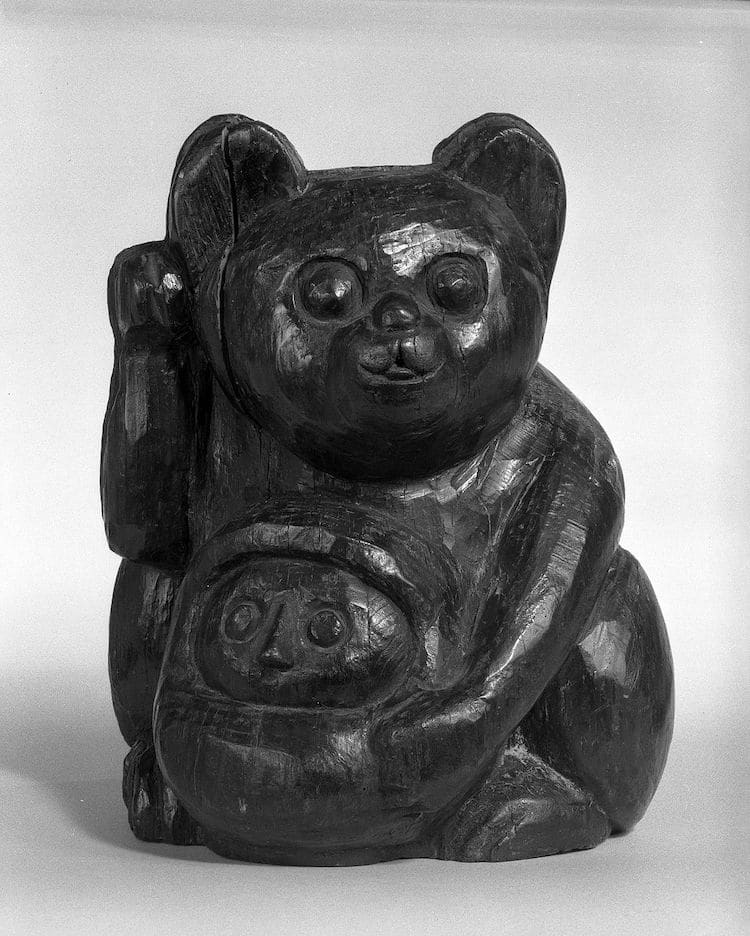
A wooden mold for a maneki-neko figure from the Edo Menstruum, 18th century. (Photo: Wikimedia Eatables, no known copyright restrictions)
Due to its popularity in Chinatowns, the maneki-neko is frequently mistaken for being Chinese. Nonetheless, the figurine is believed to have first appeared during the later part of the Edo period in Japan. The exact origins of the good luck charm is notwithstanding unknown, just i of the earliest records of the effigy appears in Utagawa Hiroshige'south ukiyo-e woodblock print from the series, Flourishing Business in Balladtown (Jôruri-machi hanka no zu), made in 1852. It depicts the Marushime-neko, a variation of maneki-neko, being sold at Senso temple, Tokyo.
During the Meiji era the maneki-neko was mentioned again in a newspaper commodity dated 1876. And at that place is also prove that kimono-clad maneki-neko were distributed at a shrine in Osaka during this time. And in 1902, an advertisement for maneki-neko indicates that the good luck charms became popular commercial items around the first of the 20th century.
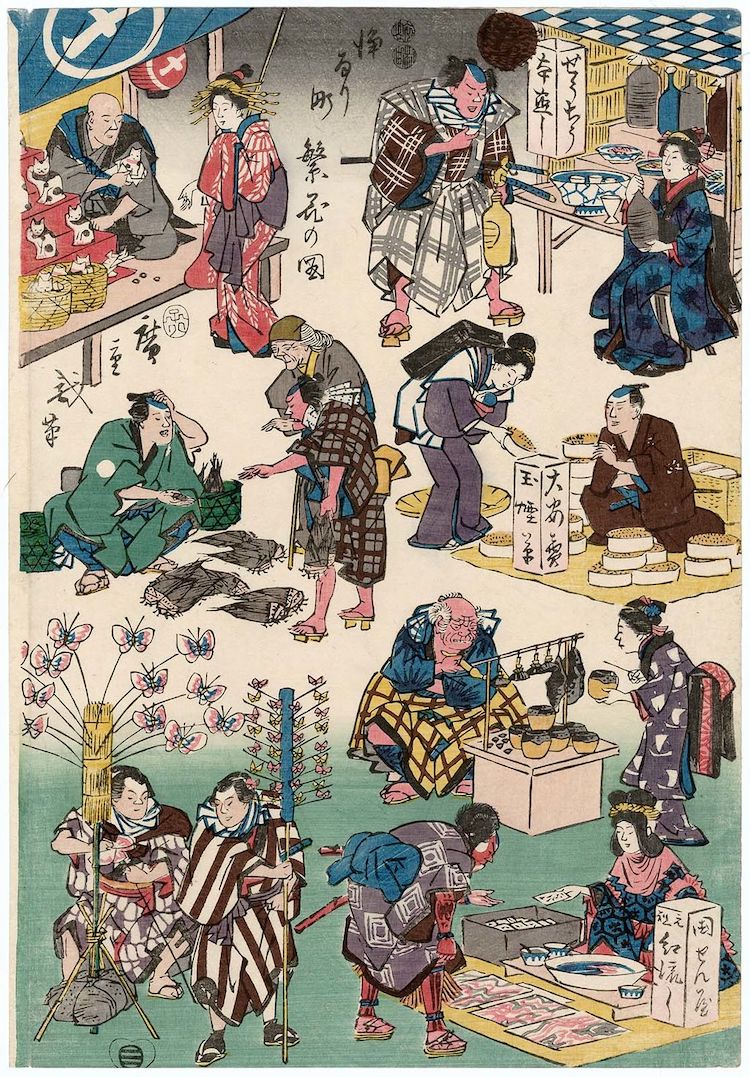
Utagawa Hiroshige's ukiyo-e style woodblock print from the serial, "Flourishing Business in Balladtown," (Jôruri-machi hanka no zu) 1852. The top left corner depicts the maru-shime no neko, a variation of maneki-neko, beingness sold at a market place. (Photo: Wikimedia Commons, Public domain)
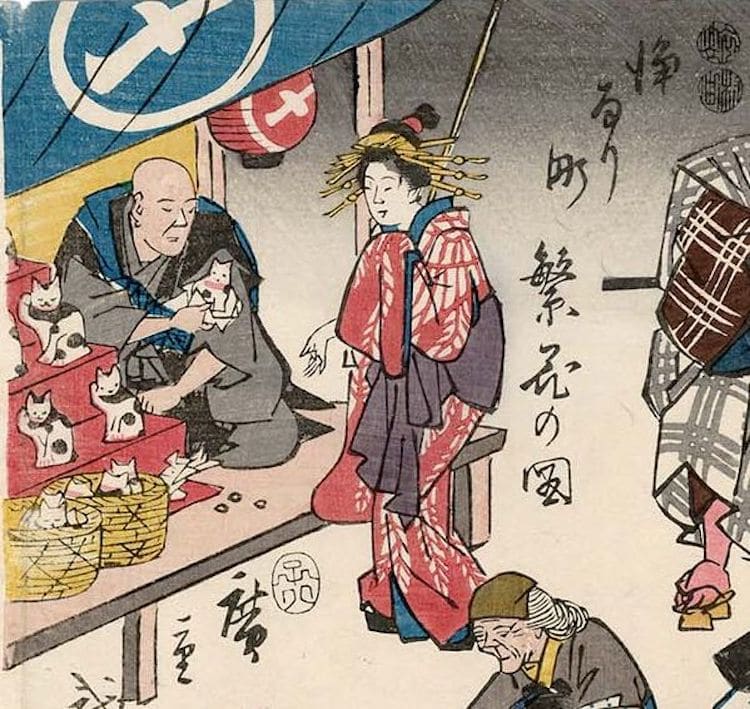
Detail from Utagawa Hiroshige's ukiyo-eastward manner woodblock impress from the serial, "Flourishing Business in Balladtown," 1852. (Photograph: Wikimedia Commons, Public domain)
The Fable of the Japanese Lucky Cat

Maneki-neko statue at Gōtoku-ji Temple. (Photo: Stock Photos from Morumotto/Shutterstock)
In Western culture, domestic cats make great pets. Just in Japanese folklore, feline friends have protective powers and symbolize good fortune. Knowing this, information technology should come as no surprise that the maneki-neko is believed to represent i specially legendary cat.
Co-ordinate to sociology, a poor, 17th-century monk lived in the small Gōtoku-ji temple in Setagaya, Tokyo with his pet bobtail cat. They lived a tranquillity life, until i day a lord samurai, Ii Naotaka of the Hikone Domain, visited the surface area. While he was on his fashion to hunt, a huge tempest erupted, and the lord took shelter nether a tree outside the temple. While there, he noticed the monk's true cat with ane mitt up, appearing as though he was waving to him to come inside the temple. Equally he moved towards the cat, a lightning bolt struck the tree where he had only been standing. Naotaka was then grateful to the cat for saving his life, that he became the patron of the temple. He helped to repair it and make more space for the poor monk. When the cat died, a statue of maneki-neko was made to commemorate its life, and the location continues to exist considered sacred today. And this story is why many people believe the beckoning cats are symbols of good fortune.
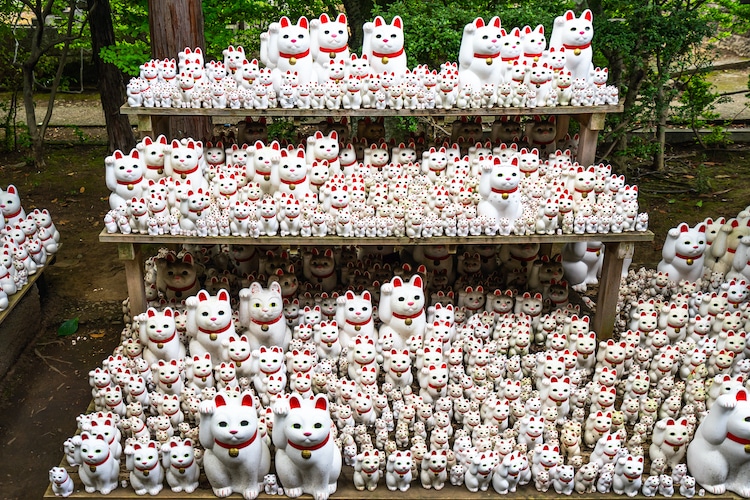
Thousands of maneki-neko statues displayed in the garden of Gōtoku-ji Temple in Tokyo, Japan. Photo: Stock Photos from Francesco Bonino/Shutterstock
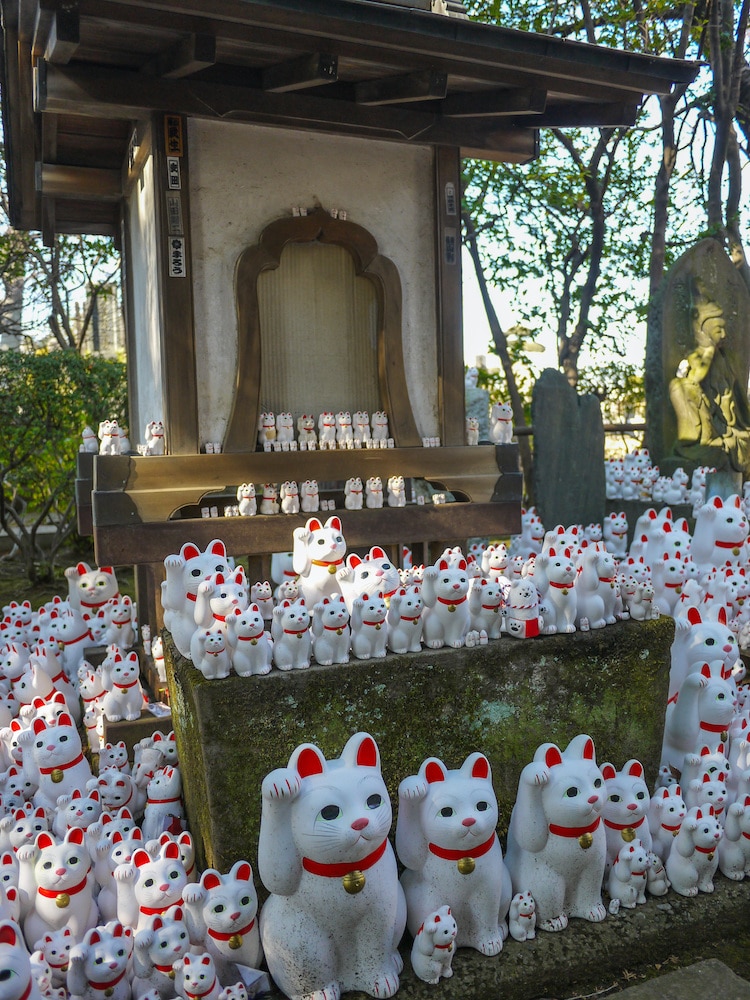
Gōtoku-ji Temple. Photo: Stock Photos from AdrianoK/Shutterstock
Where to Find Maneki-Neko
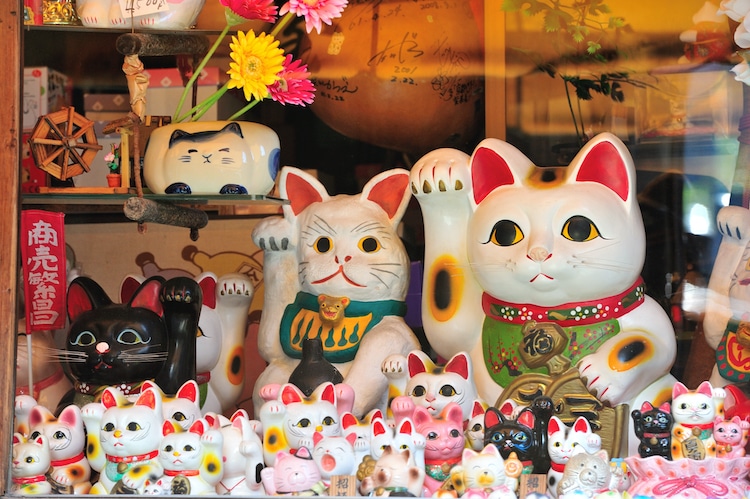
Maneki-neko displayed in a souvenir shop in Kyoto. (Photograph: Stock Photos from Eunkyung Park/Shutterstock)
Maneki-neko figurines can exist found in shops and businesses across Japan and across. Notwithstanding, if yous desire to see how they evolved throughout the ages, the Manekineko Museum of Fine art in Okayama showcases a collection of more 700 lucky cat statues from history.
The beckoning cats are besides celebrated every year in September during the Manekineko Festival in various cities across Japan. Maneki-neko events appear all over the country, and people flock to the streets with their faces painted like cats.
There's also a Manekineko-dori Street ("Beckoning Cat Street") in Tokoname Metropolis, Aichi Prefecture, where dozens of ceramic cat statues decorate the street. And of course, Gōtoku-ji Temple—where the legend of the lucky cat began—is home to hundreds of the figurines.
If you tin can't arrive to Nippon, those in the U.S. tin visit Ohio'southward Lucky True cat Museum in Cincinnati, where you'll observe over 2,000 versions of the iconic feline figure.
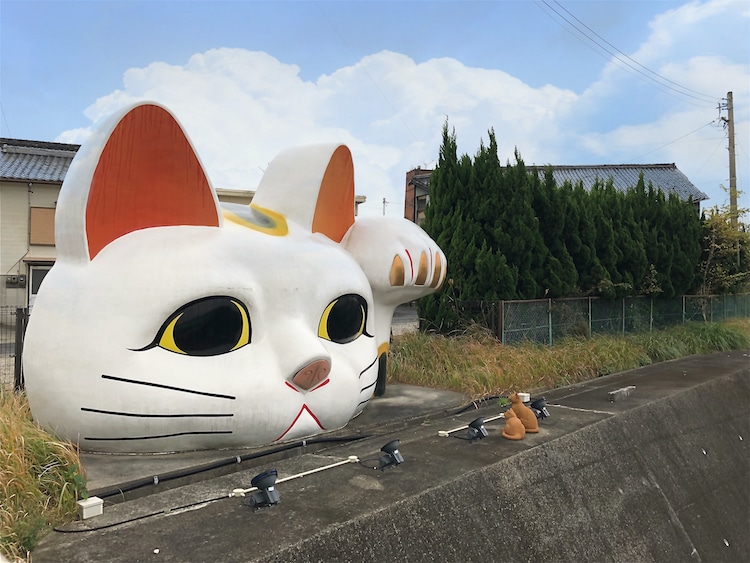
Manekineko-dori Street (Photograph: Stock Photos from Applepy/Shutterstock)
Related Articles:
Cats in Art: How Our Feline Friends Have Inspired Artists for Centuries
The Unique History and Exquisite Aesthetic of Japan'due south Ethereal Woodblock Prints
The Unique History and Fascinating Evolution of the Japanese Kimono
Origami: How the Ancient Art of Paper Folding Evolved Over Time and Continues to Inspire
How To Repair Circuit Maneki Neko,
Source: https://mymodernmet.com/maneki-neko-japanese-lucky-cat/
Posted by: morgantabstair.blogspot.com


0 Response to "How To Repair Circuit Maneki Neko"
Post a Comment